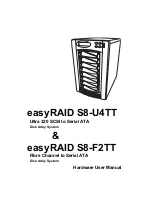
easyRAID S8
Serial ATA Disk Array Systems
3
1
O
ve
rv
iew –
Un
de
rs
ta
nd
in
g RAID
A RAID 0 array is useful in the following situations:
• Storing program image libraries or run-time libraries for rapid loading. A backup exists
because these libraries are usually supplied on read-only media.
• Storing large tables or other structures of read-only data for rapid application access. This
data should be backed up so that it can be recreated in the event of a failure.
• Capturing data from external sources at very high data transfer rates.
A RAID 0 array is not useful in the following situations:
• Applications that make sequential requests for small amounts of data. These applications
spend most of their I/O time waiting for disks to spin, whether or not they use striped
arrays.
• Applications that make synchronous random requests for small amounts of data.
RAID 1
In RAID 1, data is duplicated on two or more disks to provide high access rate and very high data
availability. This process is called mirroring. If a disk fails, the RAID controller directs all
requests to the surviving members.
A RAID 1 array is useful in the following situations:
• Availability requirements are very high
• High access rate is required
• Cost of storage is a secondary issue
Optional












































